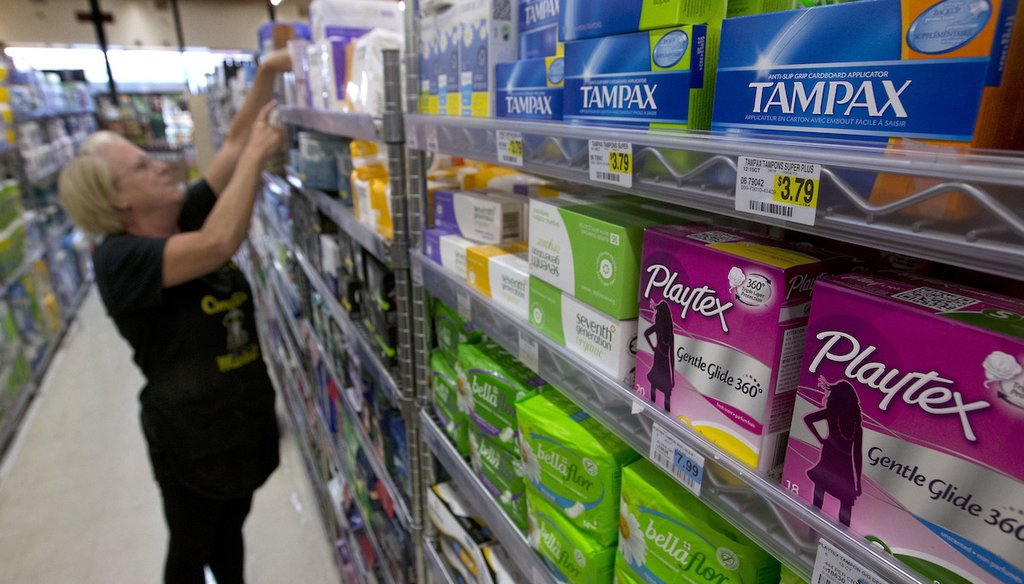Get PolitiFact in your inbox.

Feminine hygiene products are seen as an employee restocks a shelf at Compton's Market, Wednesday, June 22, 2016, in Sacramento, Calif. (AP)
If Your Time is short
-
Titanium dioxide is commonly found in countless everyday products including food, cosmetics, drugs, paper and toothpaste. Sunscreen can safely contain up to 25% titanium dioxide.
-
Some research, mostly conducted in animals, has found titanium dioxide to be harmful when inhaled and consumed, typically in large quantities. The European Union recently banned it as a food additive but the FDA has not.
-
Titanium dioxide is a common ingredient in tampons, and tampon use has not been linked to cancer or reproductive harm. But there is also no published research on vaginal or vulvar exposure to titanium dioxide that can guarantee its safety.
We need to know the truth about tampons. Period.
After a viral TikTok warned that a common ingredient in tampons was linked to cancer, many were left wondering if their preferred menstrual products were harming their bodies.
Concerns over titanium dioxide, used by many tampon brands to keep the string looking white, spread to Facebook with one user issuing a warning to her followers.
"Psa to all my girlies," the July 31 post said. "If you use these, STOP RIGHT NOW!! The titanium dioxide in it is toxic to us & causing cancerous cysts, ectopic pregnancies, & reproductive damage in humans."
The post was flagged as part of Facebook’s efforts to combat false news and misinformation on its News Feed. (Read more about our partnership with Facebook.)
Existing research sheds little conclusive light on this claim. Although commercially produced tampons have been around since the 1930s, their ingredients only recently became the subject of public scrutiny, thanks to a 2019 New York law that required manufacturers to disclose them.
The titanium dioxide many of the products contain is a naturally occurring mineral used in numerous everyday products as a pigment to keep colors bright and white or filter ultraviolet rays. The mineral’s effects have been tested primarily in animals, but some research has found it can be harmful when inhaled or consumed in large quantities — amounts not used in tampons. And though tampons have not been linked to cancer or reproductive harm, experts say more research is needed.
Sometimes referred to as titanium white or Pigment White 6, titanium dioxide is all around us. First produced commercially in 1923, titanium dioxide is found in toothpaste, printer paper, sunscreen, concealer, paints, drug tablet coatings, candies, plastics, chewing gum, eye shadow and coffee creamers, just to name a few.
Since 1966, the Food and Drug Administration has recognized titanium dioxide as a safe colorant in food, reported The New York Times, as long as it is less than 1% of the food’s total weight. According to Code of Federal Regulations, the mineral is considered "exempt from certification" in cosmetics, medical devices, and pharmaceutical drugs, meaning it has determined that the "certification of this color additive is not necessary for the protection of the public health."
In a statement provided by a spokesperson, the FDA said the agency regulates tampons as a medical device and "continues to allow for the safe use of titanium dioxide as a color additive when used according to the specifications requirements, including usage in amounts not to exceed the minimum reasonably required to accomplish the intended coloring effect."
Tampons require the FDA’s premarket review evaluating the product’s safety and effectiveness. Manufacturers are expected to conduct "biocompatibility" tests, assess chemical residues in the device and determine how the tampon affects the vaginal microbiome, the collection of microbes that live naturally on and inside one’s body.
The use of titanium dioxide in tampons is not explicitly regulated, because the agency only "makes clearance or approval decisions for medical devices, such as tampons, pads, and menstrual cups, as they are supplied in their final, finished form," the FDA spokesperson said.
The FDA told PolitiFact that it is not currently aware of any evidence that titanium dioxide in tampons is toxic or harms the body.
Although the FDA considers titanium dioxide safe, the World Health Organization’s International Agency for Research on Cancer classifies it as "possibly carcinogenic to humans." Its use as a food additive was banned in the European Union.
Whether titanium dioxide is toxic depends on how a person is exposed to it and in what amount.
"The potential risks of titanium dioxide vary depending on the method of exposure," said Dr. Aimee Eyvazzadeh, a gynecologist who runs a fertility clinic in California. "For example, inhaling it at high concentrations can irritate the nose and throat."
There have been studies in animals that have shown the carcinogenic effects of titanium dioxide when inhaled. But the same 2010 assessment by the International Agency for Research on Cancer did not find adequate evidence that the same was true for humans. The levels of inhalation being evaluated were in occupational conditions, like titanium dioxide manufacturing, much higher than the average consumer. Because of the mixed evidence, it was classified as "possibly" carcinogenic.
Still, the Occupational Safety and Health Administration has an established what it calls a "permissible exposure limit" to keep industry workers safe. And in 2020, The European Union’s Scientific Committee on Consumer Safety advised against aerosol and spray products that contain more than 1.4% titanium dioxide due to concerns about inhalation. But powdered cosmetics were safe up to 25%.
So inhalation at higher concentrations may not be advisable, but inhalation clearly isn’t a risk when tampons are used according to their intended purpose.
Other concerns of titanium dioxide toxicity involve food, highlighted by the recent lawsuit alleging that Skittles, a popular candy, contain a "known toxin." These worries were sparked in 2021 when, in a shift from its previous assessments, the European Food Safety Authority announced that titanium dioxide was no longer considered a safe food additive.
After a review of numerous studies, many conducted in animals given high doses of titanium dioxide, the agency reported it did not find evidence of general, organ, reproductive, or developmental toxicity. But it said that the concern of genotoxicity — the ability for a substance to harm a cell’s DNA — could not be completely ruled out. That determination prompted authorities in the European Union to ban the substance as a food additive.
Not all regulatory agencies agree: The Canada Health Department, for example, like the FDA, found titanium dioxide to be a safe food additive.
Just because titanium dioxide may show signs of toxicity when eaten or inhaled, doesn’t mean all exposure is dangerous. Sunscreen, for example, can have up to 25% titanium dioxide nanoparticles, and both the FDA and EU consider it to be safe. The Skin Cancer foundation even recommends sunscreen with titanium dioxide to protect against harmful cancer-causing UV rays.
There is no evidence that tampon use (generally) causes cancer, reproductive damage or ectopic pregnancy according to the American College of Obstetricians and Gynecologists.
The amount of titanium dioxide in each tampon is minuscule. In the brand of tampon featured in the viral post, it’s less than 0.1% of all the ingredients.
In a post on her blog The Vajenda, Dr. Jen Gunter, author and OB/GYN explained that chemistry may also be on our side. "Titanium dioxide doesn’t dissolve in water, meaning the nanoparticles aren’t going to dissolve from the tampon string and get into the blood that might be pooling in the vagina and then get absorbed by the body." Plus, Gunter explained that titanium dioxide tends to stick to whatever fabric it is on, and is not easily washed out.
And although there is no evidence that titanium dioxide in tampons is unsafe, it has never been officially investigated.
"To date, there is no published research that has researched the impacts of vaginal or vulvar exposure to titanium dioxide," Eyvazzadeh said. So while there is no evidence of danger, "we also don’t have the science to assure us that this kind of exposure is safe either. Given that titanium dioxide has already been linked to causing adverse reactions, it is not unreasonable to be cautiously concerned."
Our Sources
Email Interview with gynecologist Dr. Aimee Eyvazzadeh, Aug. 10, 2022
Email Interview with American College of Obstetricians and Gynecologists, Aug. 9, 2022
Email Interview with the Food and Drug Administration, Aug. 11, 2022,
Email Interview with the International Agency for Research on Cancer, Aug. 11, 2022
Facebook post (archived), July 31, 2022
TikTok (archived), July 29, 2022
Well + Good, "Is Titanium Dioxide in Tampons and Pads Safe?" Aug. 6, 2022
theSkimm, "What To Know About Titanium Dioxide In Tampons and Skittles," Aug. 4, 2022
The Vajenda, "Titanium dioxide isn't making tampons into toxic death sticks," Aug. 3, 2022
Kimberly-Clark, "U by Kotex Ingredients and Purposes," accessed Aug. 8, 2022
L. (tampon brand), "FAQs," accessed Aug. 9, 2022
Tampax, "What are tampons made of?" accessed Aug. 9, 2022
Chemical Safety Facts, "Titanium Dioxide | Use, Benefits, and Chemical Safety Facts," accessed Aug. 8, 2022
"Thames v Mars," accessed Aug 8, 2022
International Agency for Research on Cancer, "Monographs on the Evaluation of Carcinogenic Risks to Humans VOLUME 93 Carbon Black, Titanium Dioxide, and Talc," 2010
International Agency for Research on Cancer, "Studies of Cancer in Experimental Animals - Carbon Black, Titanium Dioxide, and Talc," 2010
Healthline, "Titanium dioxide in food — Should you be concerned?" July 21, 2021
Britannica, "Titanium Dioxide," accessed Aug. 8, 2022
Food and Drug Administration, "Color Additives Exempt from Certification - Titanium Dioxide - Foods," March 29, 2022
Food and Drug Administration, "Color Additives Exempt from Certification - Titanium Dioxide - Cosmetics," March 29, 2022
Food and Drug Administration, "Color Additives Exempt from Certification - Titanium Dioxide - Drugs," March 29, 2022
Food and Drug Administration, "Color Additives Exempt from Certification - Titanium Dioxide - Medical Devices," March 29, 2022
Food and Drug Administration, "The Facts on Tampons—and How to Use Them Safely," Sept. 30, 2020
Food and Drug Administration, "Sunscreen Drug Products for Over-The-Counter Human Use," March 29, 2022
USDA Foreign Agricultural Service, "European Union: Titanium Dioxide Banned as a Food Additive in the EU," March 3, 2022
Occupational Safety and Health Administration, "Titanium Dioxide," Jan. 13, 2021
Scientific Committee on Consumer Safety, "Opinion on Titanium dioxide (TiO2) used in cosmetic products that lead to exposure by inhalation," Oct. 6, 2022
European Food Safety Authority, "Titanium dioxide: E171 no longer considered safe when used as a food additive," May 6, 2021
European Food Safety Authority, "Safety assessment of titanium dioxide (E171) as a food additive," May 6, 2021
Journal of Nanobiotechnology, "Critical review of the safety assessment of titanium dioxide additives in food," June 1, 2018
Health Canada, "Titanium dioxide (TiO2) as a food additive: Current science report," June 20, 2022
Scientific American, "Are Skittles Toxic from Titanium Dioxide?" July 29, 2022
European Commission, "Sunscreens with titanium dioxide as nanoparticles," accessed Aug. 9, 2022
The Journal of the European Academy of Dermatology and Venereology, "Safety of titanium dioxide nanoparticles in cosmetics," Nov. 2019
The Skin Cancer Foundation, "Sunscreen Safety," June 6, 2018
Today, "New York becomes first state to require ingredients list on pads, tampons," Oct. 12, 2019
The Atlantic, "The Tampon: A History," (archived) June 2015
The New York Times, "Are Skittles Toxic? What to Know About Food Additive Titanium Dioxide," July 26, 2022
Environmental Science & Technology, "Release of Titanium Dioxide from Textiles during Washing," July 2, 2012
The Guardian, "Tampon wars: the battle to overthrow the Tampax empire," Feb. 11, 2020




































